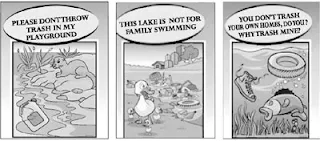A. Look at the pictures below and discuss the questions.
1. What do you see in each picture?
2. What are some of the common sources of environmental pollution?
3. Which of these sources are most threatening for your environment?
B. Now read the following passage to know more about environmental
pollution in Bangladesh.
Bangladesh is now in die grip of all sorts of pollution like air
pollution, soil pollution and water pollution. The dwellers of the urban areas
are the worst sufferers of such pollution. The indiscriminate industrialisation
process in Bangladesh over the past decades has created significant
environmental problems. We will now read about some of the most common types of
environmental pollution and ways of coping with them.
Air pollution
Air pollution comes from a wide variety of sources. In Bangladesh
poisonous
exhausts from industrial plants, brick kilns, old or poorly-serviced
vehicles and dust from roads and construction sites are some of the major
sources of air pollution.
We can minimise this type of pollution by making less use of motor
vehicles and avoiding the use of vehicles older than 20 years. We may also use
proper lubricants to lessen the level of emission and pollutants. We can
encourage people to use Compressed Natural Gas (CNG) or Liquid Petroleum Gas
(LPG) for fueling their cars. The government may relocate hazardous industries
like brick kilns to areas away from human habitations.
Water pollution
Water pollution can occur in oceans, rivers, lakes, ponds and
underground reservoirs. As different water sources flow together, the pollution
can spread easily and quickly. Causes of water pollution include:
• increased sediment from soil
• erosion
• improper waste disposal and littering
• leakage of soil pollution into water supplies
• organic materials that decay in water supplies
In fact, polluting the land means polluting the water. Throwing away a
toxic substance on the ground near a water source means it eventually reaches
the body of water. As a result, the water is polluted. Industrial wastes must
not be disposed in rivers or lakes. We need to be more careful about disposing
household wastes too. Use of pesticides means that when it rains, chemicals
used in the lawn or garden wash into the water bodies. Therefore, we must be
aware of the dangers of using pesticides as they may pollute our rivers, canals
and lakes.
Soil pollution
Among the most significant causes of soil pollution is the enormous
volume of industrial waste which is being produced every day but not disposed
properly. The mismanagement of household wastes, particularly the polythene
shopping bags, has caused serious threat to the soil and the drainage system.
Another cause for soil pollution is the use of agricultural pesticides,
fertilizers, etc. Sometimes fuel leakages from automobiles may get washed away
by rain and seep into the nearby soil.
Pesticides and fertilizers are useful for plant growth but their
overuse has led to soil pollution. Natural fertilizers and compost can be used
instead of their chemical alternatives. Recycling is another way to reduce and
control soil pollution. Recycling papers, plastics and other materials reduces
the volume of refuse in landfills. De-forestation also causes erosion,
pollution and the loss of fertility in the topsoil. Planting trees and
re-forestation help prevent soil erosion and pollution.
C. From your reading of the above text complete each blank space in
the table with no more than two words and/or numbers.
Pollution
|
Causes
|
Suggestions
|
Air pollution
|
• Toxic
smokes from
plants
• Vehicles
which are old
and poorly
• Smoke from the
fields |
• Don't
drive motorcars
which are older than years.
• Use car lubricants of good
quality to keep the
......................... level
minimum.
|
• Use CNG or LP gas as car
|
||
Soil pollution
|
• Industrial wastes not
properly.
• Use of.......................
shopping bags
• Use of agricultural pesticides and
|
• Use
compost for
agricultural purpose.
•.................................... paper,
plastics, and other
materials.
Plant more trees to help
prevent loss of fertility in the...................................... |
D. In groups of four, prepare a summary in 100 words of the topic
below. First, work together to prepare a draft. When the draft is complete,
select a group member to read it to the class.
Topic: Polluting the land means polluting the water
E. Look at the three posters below. What messages do they give?
Which one do you like the most? Tell your friend why you like it.
If you want to read the next lesson of this unit please click the link below:
Lesson: 3 | Man and climate






0 Comments:
Post a Comment